Cervical hernia - a disease in which there is a protrusion of fragments of the intervertebral disc into the spinal canal.
Going beyond the anatomical boundaries leads to the involvement of nerve endings, the spinal cord, as well as large vessels, which provokes the manifestation of specific symptoms. Treatment of the disease is carried out with the help of conservative therapy, as well as surgery.
Record content:
- 1 Views
- 2 Stages and degrees
- 3 Symptoms
- 4 Reasons for the appearance
- 5 Diagnostics
- 6 When to see a doctor
- 7 Prevention
-
8 Treatment methods
- 8.1 Medications
- 8.2 Folk methods
- 8.3 Gymnastics
- 8.4 Other methods
- 9 Possible complications
- 10 Video about cervical hernia
Views
Depending on the location, cervical hernias are divided into 4 types:
| Anterior ventral | The protrusion of the fibrous nucleus occurs in the direction opposite to the spinal canal. |
| Lateral lateral | The location of the hernia in the area of the lateral parts of the intervertebral disc. |
| Posterior median | Protrusion of the fragment into the center of the spinal canal. |
| Posolateral paramedian | The deformed fragments are deflected by several degrees towards the axis leading to the spinal canal. |
There is another classification, according to which hernias are divided into types depending on their parameters:
-
protrusion - the size of the hernia does not exceed 3 mm, the pathology does not manifest itself and is detected by chance during radiography;
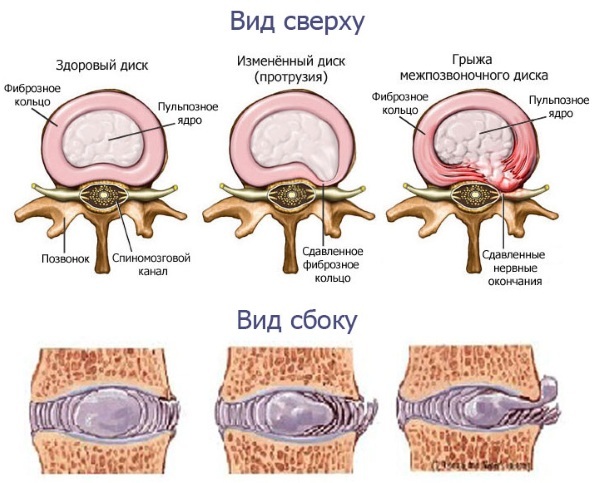
- prolapse - the size of the hernia reaches 3-6 mm, its appearance provokes the onset of pain syndrome, which is of a periodic nature;
- extrusion - the area of protrusion exceeds 6 mm;
- sequestration - the diameter of the hernia varies from 7 to 15 mm, the treatment of the pathology requires surgical intervention.
Stages and degrees
A cervical hernia (symptoms and treatment affect the speed of recovery) goes through several stages, each of which characterized by different intensity of manifestation of symptoms:
- Stage I - violation of the integrity of the annulus fibrosus, which results in the release of a small part of the jelly-like nucleus;
- Stage II - circulatory disorders in the area of the intervertebral disc and swelling of the nerve root;
- Stage III - exit of the nucleus pulposus beyond the intervertebral disc;
- Stage IV - loss of fragments of the nucleus pulposus and the limits of the disc, which leads to displacement of the intervertebral discs.
Symptoms
At the initial stage of the disease, the manifestations of hernia are associated with pain and vertebral syndromes caused by irritation of the spinal root at the level of the developing hernia. Pain syndrome is periodic in nature and occurs during turns and tilts of the head. With the further development of the disease, the pain becomes permanent and intensifies.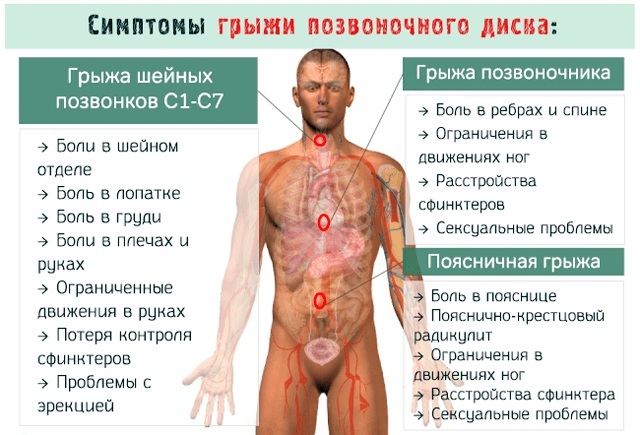
Symptoms of the pathology will depend on which of the 7 vertebrae of the cervical spine is the hernia.
| Location between 1st and 2nd vertebra |
|
| Between 2 and 3 |
|
| Between 3 and 4 |
|
| Between 4 and 5 |
|
| Between 5 and 6 |
|
| Between 6 and 7 |
|
Reasons for the appearance
A cervical hernia (symptoms and treatment are interrelated, since the nature of the manifestation of the disease affects the chosen method of therapy) develops due to degenerative processes in the disc caused by the following diseases:
- osteochondrosis;
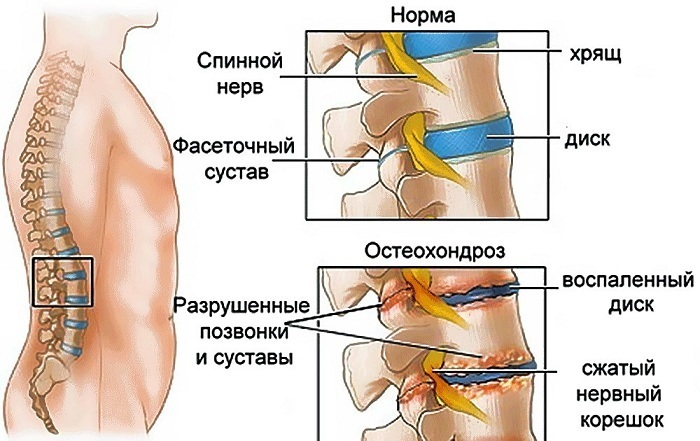
- cervical spondylosis;
- spondyloarthrosis;
- spinal tuberculosis.
Disc degeneration is also provoked by various dysmetabolic processes that occur when:
- diabetes mellitus;
- alcoholism;
- smoking;
- obesity.
An unhealthy lifestyle leads to a slowdown in the supply of nutrients to the fragments of the spinal column, they lose their elasticity and firmness.
An increased load on the cervical spine, as well as acute spinal injuries - bruises and subluxations, leads to the formation of cracks in the fibrous ring of the disc. As a result, a part of the disc leaves the intervertebral space.
Other factors that increase your risk of developing a cervical hernia include:
- violation of posture;
- the presence of anomalies in the development of the spine;
- cervicothoracic scoliosis;
- hereditary predisposition;
- excessive physical activity.
Diagnostics
The diagnosis is made on the basis of the conducted instrumental research methods.
At the initial stage of the disease, with severe pain syndrome, an X-ray of the spine is performed, which makes it possible to identify pathological changes in the bone structures of the spinal column. This type of study indicates only indirect signs of pathology - the presence of osteochondrosis or spondyloarthrosis.
Other diagnostic methods include:
-
Spine MRI - a diagnostic method based on the effect of a magnetic field in the investigated area. With the help of MRI, it is possible to obtain layer-by-layer images of the spine in three planes - horizontal, lateral and straight. This is the most informative method of examination, which allows visualizing a cervical hernia, determining its exact location and assessing the size, as well as the degree of narrowing of the spinal canal. Diagnostics can be carried out natively or with the use of a contrast agent. Cost - from 5000 rubles.

Cervical hernia. Symptom in MRI diagnosis - CT scan - non-invasive method of examining the vertebrae and intervertebral discs located at the neck level. CT allows you to get an image of slices of the body using a tomograph. Based on the data obtained, two-dimensional and three-dimensional models of the cervical vertebrae are created, which greatly facilitates the process of diagnosing the disease. Research cost - from 1400 rubles.
- Myelogram - X-ray examination using a contrast agent, which is introduced into the spinal canal by a puncture method into the subarachnoid space of the vertebra under study. Then, with the help of a special apparatus, images are reproduced, with the help of which the sizes and boundaries of the deformation of the intervertebral space are estimated. Oxygen, nitric oxide or demirex are used as a contrast agent to illuminate problem areas. Cost - from 5000 rubles.
When to see a doctor
A cervical hernia is a dangerous disease that can lead to a complete loss of capacity, therefore, at the first manifestations of symptoms of pathology, it is necessary to consult a neurologist. The doctor will choose the appropriate diagnostic method, on the basis of which the treatment will be prescribed.
Signs, the manifestation of which indicates the need for medical attention:
- shooting pain in the neck, shoulder and arm, aggravated by head movement;
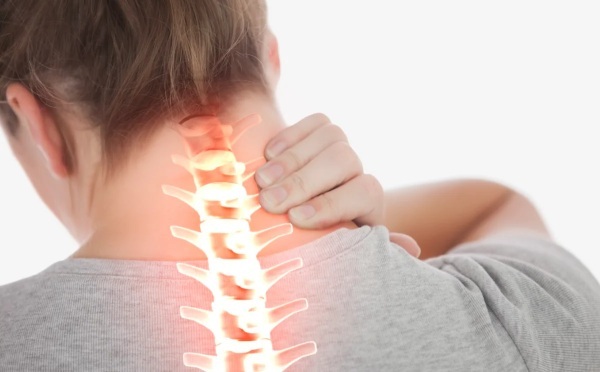
- the occurrence of weakness in the limbs and a decrease in muscle tone;
- slight tingling and numbness of the hand in the area of the thumb or little finger;
- dizziness, headaches, tinnitus or loss of visual acuity against the background of general pain in the cervical spine;
Pathology is treated not only by a neurologist, but also by an orthopedist, vertebrologist, and also a chiropractor.
Prevention
To prevent cervical hernia and reduce the likelihood of developing the disease, the following recommendations must be observed:
- avoid hypothermia;
- to live an active lifestyle;
- monitor posture
- avoid heavy loads on the spine;
- choose hard orthopedic mattresses for sleeping;
- avoid excessive weight gain.
Treatment methods
Treatment of a cervical hernia is carried out using conservative therapy and surgery. During the recovery period, manual therapy, myofascial massage and reflexology are used to reduce pressure on the affected intervertebral disc. Physiotherapy methods are actively used.
Medications
Drug therapy for the treatment of cervical hernia includes the following groups of drugs:
- non-steroidal anti-inflammatory drugs (NSAIDs);
- corticosteroids;
- muscle relaxants;
- chondroprotectors;
- sedatives.
NSAIDs are used to manage pain and relieve inflammation. This group of drugs is not suitable for long-term treatment and is used to eliminate concomitant symptoms.
NSAIDs are available in the form of tablets and ointments for topical use:
-
Ibuprofen - a drug in the form of tablets with analgesic and anti-inflammatory effects. The mechanism of action is associated with the inhibition of prostaglandins, which play a key role in the manifestation of inflammation and pain. A single dose for adults is 200-800 mg with a frequency of administration 3-4 times a day. Cost - from 50 rubles.
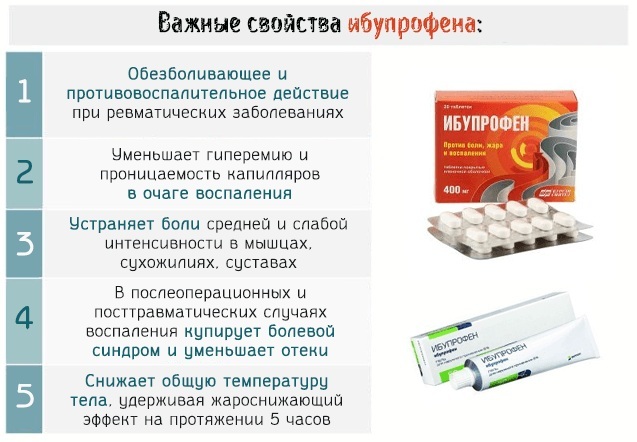
- Ketanov - a derivative of pyrrolysine-carboxylic acid, which has a pronounced analgesic and anti-inflammatory effect. The drug is taken orally at 10 mg every 4-6 hours. The maximum allowable duration of use is 2 days. Cost - from 55 rubles.
- Meloxicam - an enolic acid derivative in the form of tablets, which eliminates inflammation and pain. The drug is prescribed at 7.5-15 mg 1 time per day. Cost - from 50 rubles.
Corticosteroids are a group of drugs with an active anti-inflammatory effect, which are used in cases where NSAIDs do not give the desired effect. Corticosteroids block the production of all substances that cause inflammation, pain and swelling.
These include:
- Hydrocartizone - a suspension with anti-inflammatory effect. The drug is administered intravenously at 100 mg every 2-6 hours, depending on the clinical situation. The cost is about 200 rubles.
- Prednisolone - a drug in the form of tablets that suppresses the function of leukocytes and tissue macrophages. In adults, the initial dose is 20-30 mg per day, if necessary, it can be increased to 100 mg. The duration of treatment is determined individually. Cost - from 120 rubles.
Muscle relaxants are drugs used to relieve spasm of tight muscles.
This group of funds includes:
- Tizalud - a drug in the form of tablets that relieves increased skeletal muscle tone. The tool is used 3 times a day at a dosage of 2-4 mg. Price - from 157 rubles.
- Mydocalm - a muscle relaxant of central action in the form of tablets. Adults are prescribed 150-400 mg of the drug per day, divided into 3 doses. The tablets are taken after meals with plenty of water. The cost is about 350 rubles.
Chondroprotectors are a group of drugs designed to restore and strengthen articular cartilage:
-
Artra - tablets that stimulate the regeneration of cartilage tissue. The drug is prescribed in a dosage of 1 tablet 2 times a day. To achieve a pronounced therapeutic effect, the agent is used within 6 months. Cost - from 2300 rubles.
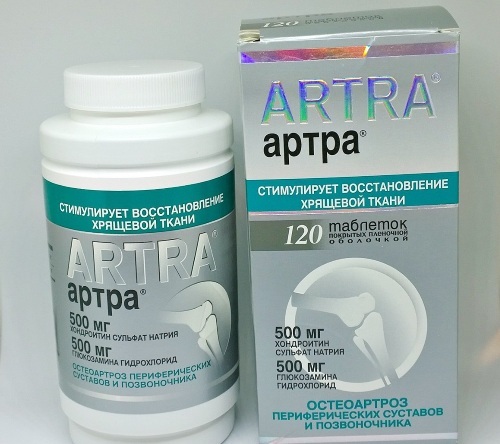
- Don - a drug that has anti-inflammatory and analgesic effects. Increases the permeability of the joint capsule and inhibits the development of degenerative processes in the joints. Adults are prescribed 1 tablet 2 times a day with meals. The minimum course of taking the drug is 4-6 weeks. Cost - from 1300 rubles.
Sedatives relieve the neurological symptoms of cervical hernias.
This group of medicines includes:
- Phenazepam - a drug that has a sedative and central muscle relaxant effect. Adults are prescribed 2-3 mg 1-2 times a day. The daily dose should not exceed 10 mg. duration of admission - no more than 2 weeks in order to avoid the development of addiction. Price - 200 rubles.
- Novopassit - a combined preparation with a sedative effect based on medicinal herbs. The tool is taken 1 tablet after meals 3 times a day. Cost - from 230 rubles.
Folk methods
Cervical hernia (symptoms and treatment affect the choice of auxiliary methods for eliminating pathology) causes the manifestation of symptoms, the intensity of which can be reduced with the help of folk remedies medicine.
To eliminate pain and inflammation, you can use ointments, rubbing and applications based on medicinal herbs:
- Juniper Tincture. Pour 100 g of juniper with 0.5 l of vodka, place in a glass bottle and seal with a lid. Soak the tincture for 3 weeks and rub the affected areas every night before going to bed.
- Homemade mummy ointment. Crush 5 g of mummy and dissolve the substance in 30 ml of water. Then add 20 ml of medical alcohol and 80 g of petroleum jelly to the mixture and mix thoroughly. Apply ointment daily to areas with severe pain.
-
Compress of honey and aloe juice. At 1 st. l. aloe juice take 2 tbsp. l. alcohol and 3 tbsp. l. liquid honey. Mix all the components thoroughly and use the mixture as a compress, applying it to gauze bandages and applying to the affected area of the neck.

- Grinding solution from propolis. Pour 30 g of crushed propolis with 100 ml of alcohol. Pour the mixture into a glass container and incubate for 10 days. Rub the affected areas with a ready-made solution 1-2 times a day.
- Horse fat compress. In a container, mix 100 ml of horse fat purchased from a pharmacy, 20 ml of iodine and 2 egg yolks. Mix all ingredients thoroughly. Put the resulting mixture on gauze napkins and apply to painful areas, fixing the compress with a plaster. Perform manipulations daily for 10 days.
Gymnastics
Therapeutic gymnastics is one of the types of therapy for a hernia of the cervical spine. It allows you to reduce pain in the cervical spine, strengthen the muscles, relieve spasms and improve the flexibility of the spinal column. There are several complexes of exercise therapy that are used separately for the acute period and the period without exacerbations.
All exercises in the acute course of the disease should be performed smoothly and slowly, without making sudden movements:
- Take a sitting position and put your hands on your hips. Perform circular movements of the arms in the shoulder joint.
- In a sitting position, raise your straight arms up, and then spread them to the sides, then return to the starting position and repeat all the actions again.
- In a sitting position, stretch your arms forward, holding them in front of you, then raise them up. Repeat the steps 5-7 times.
- In the supine position, stretch your arms along the body and actively wiggle your fingers for 1 min.

Exercises outside the exacerbation period:
- While sitting on a stool, make careful circular movements with your head.
- Without changing the position, tilt the head in different directions.
- In the supine position, tear the heads off the floor, fixing this position for 10 seconds, and then return to the starting point.
- In a position on all fours, slowly lower your head down.
In the absence of contraindications, classes are carried out daily, 5 times a week. The duration of classes increases gradually from 8-10 minutes to 35-40 minutes. Each exercise should be repeated at least 6-8 times.
Other methods
A cervical hernia (symptoms and treatment affect the nature of the course of the disease) requires an integrated approach, therefore, in addition to drugs to eliminate it the following methods of conservative therapy are used:
- Physiotherapy helps to reduce the severity of symptoms and reduce pain. In case of illness, the following procedures are carried out:
- electrophoresis with novocaine - delivery of medicines to the affected areas using electric current;
- magnetotherapy - the use of a pulsed or constant magnetic field acting on the affected areas by accelerating processes in tissues at the molecular level;
-
paraffin therapy - a procedure during which molten paraffin is used, applying it to the affected area using a special applicator.
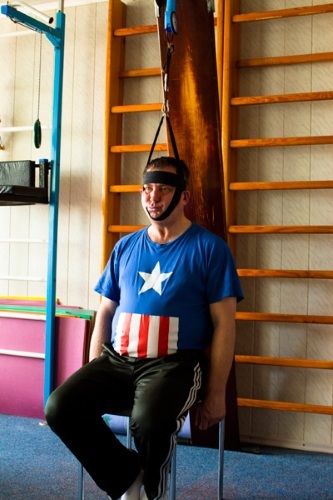
- Manual therapy - a technique in which a specialist chiropractor acts on special areas of the spine and contributes to its stretching in the cervical spine. This allows the disc to return to its natural position. This type of therapy is not suitable for the advanced stage of the disease.
- Acupuncture - a method of exposure with needles, which irritate the receptors of the skin and activate metabolic and regenerative processes in it.
- Using Glisson Loop - a special device designed to stretch the cervical spine. The design allows you to relax the muscles of the spine, improve blood flow in the cervical spine and relieve tension.
- Wearing special bandages required to fix the affected spine in a natural position. For the treatment of cervical hernia, a Shants collar is used - a removable structure worn around the neck. The device is made of soft foam and hard polyurethane foam. There are several types of bandages - soft, semi-rigid, rigid and inflatable.
Surgical methods of treatment are used in the case of advanced stages of the disease, when:
- the size of the formation exceeds 10-15 mm;
- there is a threat of complete loss of legal capacity;
- conservative therapy does not bring the desired results.
With a hernia of the cervical spine, the following types of operations are distinguished:
- anterior cervical discectomy - surgery, in which the damaged disc is removed through an incision in the front of the neck, and on it a special graft made of artificial material or extracted from the iliac bones.
- microdiscectomy - Removal of a hernia together with an intervertebral disc using an operating microscope. Removal of the disc occurs through a small incision, without violating the integrity of the surrounding tissues;
- laser vaporization - a method of surgical intervention that allows you to eliminate a hernia using a quartz LED, which is inserted into a small puncture in the area of the affected disc.
Possible complications
All types of hernias of the cervical spine are dangerous to human life, since the cerebral blood vessels that feed the brain are located in the neck. Any violation of blood circulation can provoke a spinal stroke, which will lead to a complete loss of performance.
Other consequences of a cervical hernia include:
- amyotrophy;
- weakening of reflexes;
- auditory and visual impairment;
- full or partial reduction in sensitivity.
A cervical hernia is a rather serious pathology, the symptoms of which begin to appear already in the early stages. Lack of timely treatment of the disease can lead to the development of a stroke or complete disability.
Video about cervical hernia
Shishonin on the intervertebral hernia in the neck:



